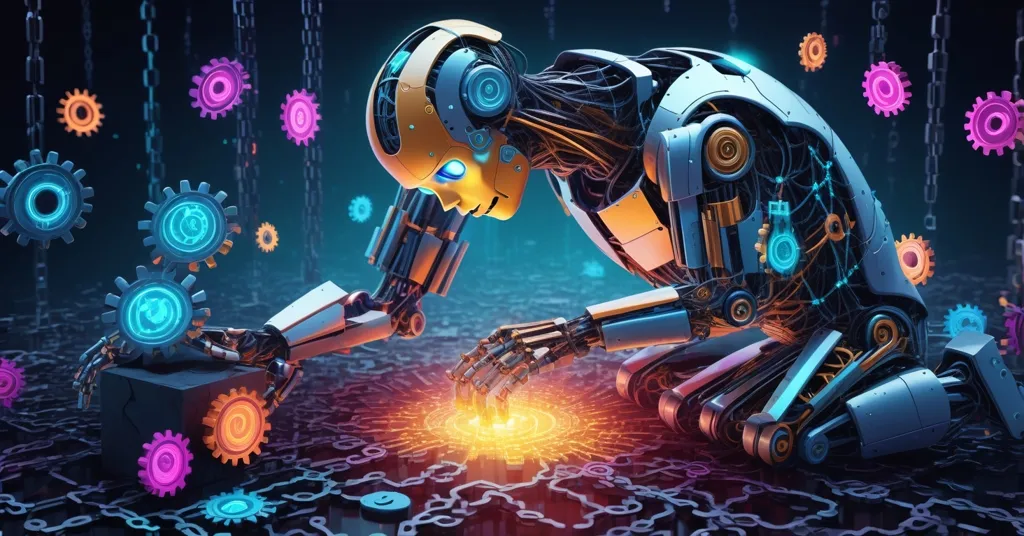AI Innovation Stalls: Can Blockchain Revive the Future of Tech?

Has AI Innovation Hit a Wall? Unpacking the Slowdown and Blockchain’s Potential Role
Artificial Intelligence (AI) burst onto the scene as the ultimate game-changer, promising to automate everything from daily chores to entire industries. Yet, after an explosive run from 2022 to 2024, the momentum seems to be grinding to a halt. Are we witnessing the end of AI’s golden era, or is this a pause before the next breakthrough—and could blockchain, a cornerstone of decentralized tech, provide the spark needed to reignite progress?
- AI’s Rise and Stall: After rapid advancements with tools like ChatGPT and GPT-4, AI innovation is slowing due to diminishing returns and unmet promises of autonomous systems.
- Data and Consumer Gaps: A shortage of quality training data and tools that alienate everyday users are choking AI’s growth.
- Blockchain as a Fix: Decentralized systems could tackle data integrity and compute challenges, offering a lifeline to AI’s future.
AI’s Meteoric Rise Turns to a Crawl: What Happened?
AI’s trajectory over the past few years has been nothing short of a rollercoaster. It all started with a bang in November 2022 when OpenAI dropped ChatGPT, a chatbot that wowed the world with its ability to hold human-like conversations. Barely four months later, GPT-4 rolled out, upping the ante with features like Code Interpreter and Advanced Data Analysis that made jaws drop. Tech giants, gripped by the fear of being left behind, churned out updates every 30 to 120 days in a cutthroat race for dominance. The promises were dazzling—autonomous AI agents that could think and act on their own, creative tools to outshine human artists, and automation so slick it would flip the workforce upside down. But let’s be real: these lofty dreams have crashed harder than a leveraged altcoin trade in a bear market. Most users today just tap AI as a glorified search engine or “answer engine,” nowhere near the sci-fi utopia we were pitched. For deeper insights into this slowdown, check out this analysis on AI innovation challenges.
So, why the screeching halt? Industry insiders have pointed out a sobering truth—AI seems to be sliding out of its explosive early phase into a rut of stagnation. As one observer starkly noted:
AI looks like it’s beginning to exit its early-stage growth phase and enter a period of stagnation.
The obsession with tweaking underlying models has hit a brick wall of diminishing returns. Early upgrades, like the jump from ChatGPT to GPT-4, delivered mind-blowing improvements. But now? Each new version barely moves the needle, even as companies like OpenAI dump mind-boggling resources into development. One expert captured it perfectly, as detailed in this report on GPT-4 performance updates:
The biggest AI labs have been obsessively improving their underlying models. At first, those improvements in their AI models made a big, noticeable difference from version to version. But now, we’ve reached the point of diminishing returns in model optimization.
The Data Drought and Compute Crunch: AI’s Twin Nightmares
At the heart of AI’s woes lies a crippling shortage of high-quality training data. These models guzzle vast amounts of unique, human-generated content to learn and improve. Problem is, AI labs have likely scraped every nook and cranny of the public internet already. Projections suggest that by 2027 or 2028, the well of usable human text for large language models (LLMs) will run bone dry. Why? The internet isn’t growing fast enough to keep up, and privacy laws like GDPR in Europe and CCPA in California are locking data behind legal barricades, creating silos that starve AI systems. Labs are now turning to synthetic data—content generated by AI to train AI—but it’s a risky gamble. Think of it as making photocopies of photocopies; each round gets blurrier, amplifying errors and degrading quality, especially for broad language tasks. This issue is further explored in discussions around data scarcity for AI training.
Then there’s the compute and energy crunch. Training models like GPT-4 reportedly cost over $100 million, with future iterations potentially ballooning into billions. Meanwhile, data centers powering these beasts are projected to nearly double their energy consumption by 2030, from 460 terawatt-hours in 2021 to a staggering 848 terawatt-hours. It’s not just a money problem; it’s an environmental disaster waiting to happen. With costs skyrocketing and Mother Nature taking a beating, the raw economics of AI innovation are starting to look unsustainable. Is brute-force scaling even feasible anymore, or are we flogging a dead horse? For a broader context on AI’s evolution and challenges, take a look at this overview of artificial intelligence.
Consumer Disconnect: AI Isn’t Speaking Our Language
Here’s another bitter pill—most AI tools are about as user-friendly as a Rubik’s Cube in the dark. Built by tech geniuses for tech geniuses, they leave the average Joe baffled and uninterested. Consumers aren’t clamoring for overengineered toys; they want straightforward solutions to real headaches. One sharp critique hit the nail on the head:
Consumers want AI products and tools that solve real problems in their lives, are intuitive, and can be used without having a STEM degree.
Instead, we’re stuck with clunky, niche products that feel irrelevant to everyday life. If AI wants to claw its way out of this slump, it needs to zero in on narrow, high-impact use cases—think personal finance assistants or health symptom trackers—that actually make a difference without needing a PhD to operate. Until then, it’s just shiny lab experiments collecting digital dust.
Can Blockchain Be AI’s Saving Grace?
If data is AI’s Achilles’ heel, could a decentralized fix be the answer? Enter blockchain technology, a hero in the world of decentralization, with the potential to tackle some of AI’s nastiest roadblocks. Data integrity and ownership are massive pain points—labs face disputes over who owns what data, plus the risk of tainted or biased datasets. Enterprise blockchain systems, with their tamper-proof ledgers, offer a way to verify the provenance of every scrap of training data, ensuring quality and transparency. For more on this synergy, explore these case studies on blockchain integration in AI. As one forward-thinking idea puts it:
In order for artificial intelligence (AI) to work right within the law and thrive in the face of growing challenges, it needs to integrate an enterprise blockchain system that ensures data input quality and ownership—allowing it to keep data safe while also guaranteeing the immutability of data.
This isn’t just theoretical fluff. Projects like Ocean Protocol are already building decentralized data marketplaces where contributors can share and monetize data via tokenized ecosystems. Imagine a platform where individuals sell anonymized health records for medical AI research, getting crypto tokens in return while retaining control over their privacy. Then there’s self-sovereign identity—a blockchain-based concept letting users own their digital footprints, like holding the key to your own data vault. It’s a perfect fit for the freedom and privacy ethos we champion in the crypto space. Curious about this intersection? Check out community insights on blockchain’s role in solving AI data issues.
Blockchain could also ease AI’s compute crunch. Decentralized networks like Golem and Render Token distribute processing power across global nodes, slashing costs and environmental impact compared to centralized data centers chugging energy like there’s no tomorrow. Even storage gets a boost—Filecoin offers decentralized solutions for housing massive datasets, sidestepping the monopolistic grip of Big Tech cloud providers. For us Bitcoin maxis, this resonates deeply; just as Bitcoin disrupts centralized finance, blockchain could decentralize AI’s infrastructure, aligning with our push for effective accelerationism—tech progress without the suffocating overreach of gatekeepers. Learn more about this potential in this overview of decentralized compute systems for AI.
Hold the Hype: Blockchain Isn’t a Magic Bullet
Before we get too starry-eyed, let’s pump the brakes. Blockchain isn’t a cure-all for AI’s mess. For one, it has its own baggage—some networks guzzle energy worse than a proof-of-work Bitcoin miner circa 2017, which undercuts the sustainability argument. Scalability is another sore spot; blockchain transactions can be sluggish compared to centralized systems, a real problem when AI training demands speed. And don’t forget adoption hurdles—getting enterprises to ditch legacy systems for decentralized tech is like convincing a boomer to hodl BTC overnight. Regulatory clashes loom large too; blockchain’s transparency might butt heads with data anonymization laws, creating legal gray zones that could stall progress. For a deeper dive into how blockchain might advance AI, see this discussion on blockchain’s impact on AI innovation.
Then there’s the broader skepticism about AI itself. Much like altcoin pumps promising 100x returns, AI’s grand visions of autonomous agents feel more like slick marketing than reality. Synthetic data, often hyped as a quick fix, risks turning models into echo chambers of garbage outputs. Even promising tricks like Mixture-of-Experts (MoE)—where AI splits tasks among specialized sub-models like a team of experts—and Retrieval-Augmented Generation (RAG)—which pulls real-time info from external databases—aren’t silver bullets. They stretch resources further but don’t fully solve the data drought or compute crisis. Maybe it’s time to ditch the sci-fi fantasies and grind out practical, incremental wins instead.
What This Means for Crypto Enthusiasts
For those of us knee-deep in the crypto game, the AI-blockchain crossover is a space to watch. Bitcoin itself isn’t built for AI data or compute tasks, but its ethos of decentralization and privacy could inspire frameworks that keep AI from becoming another Big Tech fiefdom. Post-halving, as mining profits tighten, could we see miners repurposing their rigs for decentralized AI compute networks? Altcoin projects like SingularityNET are already blending AI and blockchain, creating marketplaces for AI services paid in tokens. This isn’t just tech for tech’s sake—it’s about ensuring AI evolves in a way that respects ownership and freedom, values we’ve fought for since Satoshi dropped the genesis block. Research on data integrity through blockchain in AI highlights the potential for such synergies.
Geopolitical tensions over data add another layer. Nations are battling for control of this digital gold, much like they’ve sparred over Bitcoin’s borderless nature. Blockchain could break down these data silos, enabling secure, cross-border sharing without handing power to any single overlord. But we’ve got to stay sharp—regulatory minefields and overhyped promises in both AI and crypto remind us to keep a critical eye. Are we accelerating responsibly, or just buying into another bubble?
Key Takeaways and Burning Questions
- Why is AI innovation slowing after its 2022-2024 boom?
Diminishing returns on model upgrades, a critical shortage of unique training data by 2027-2028, and tools that don’t click with everyday users are dragging progress down. - How are people really using AI compared to the big promises?
Most treat it as a basic search or answer tool, not the autonomous workforce killer or creative genius tech giants hyped it to be. - Can blockchain solve AI’s data and compute problems?
It offers potential with immutable ledgers for data integrity via projects like Ocean Protocol and decentralized compute via Golem, but scalability and energy issues remain hurdles. - Are there internal AI fixes to this plateau?
Techniques like Mixture-of-Experts and Retrieval-Augmented Generation improve efficiency, but they can’t fully overcome data scarcity or unsustainable energy costs. - Should crypto fans care about AI’s struggles?
Absolutely—blockchain-AI integration could mirror Bitcoin’s disruption of finance, pushing decentralized, privacy-first tech, while projects like SingularityNET tie directly to token economies. - Is AI hype just another crypto-style bubble?
Quite possibly—the overblown promises echo altcoin scams, and without grounding in practical tools, both fields risk crashing under their own weight.
AI stands at a crossroads, grappling with data deserts, energy black holes, and tools that miss the mark for most of us. Yet, this isn’t game over—it’s more like a gritty reboot. By pivoting to intuitive, problem-solving products and tapping into decentralized tech like blockchain for data and compute solutions, the spark could reignite. For the crypto crowd, this intersection is electric; blockchain’s potential to decentralize AI mirrors our fight against centralized control, ensuring tech evolves with privacy and freedom at its core. Let’s keep our eyes peeled and our skepticism sharp. The next chapter of AI could be revolutionary—if it plays its cards right and learns a thing or two from Bitcoin’s relentless push against the status quo.



